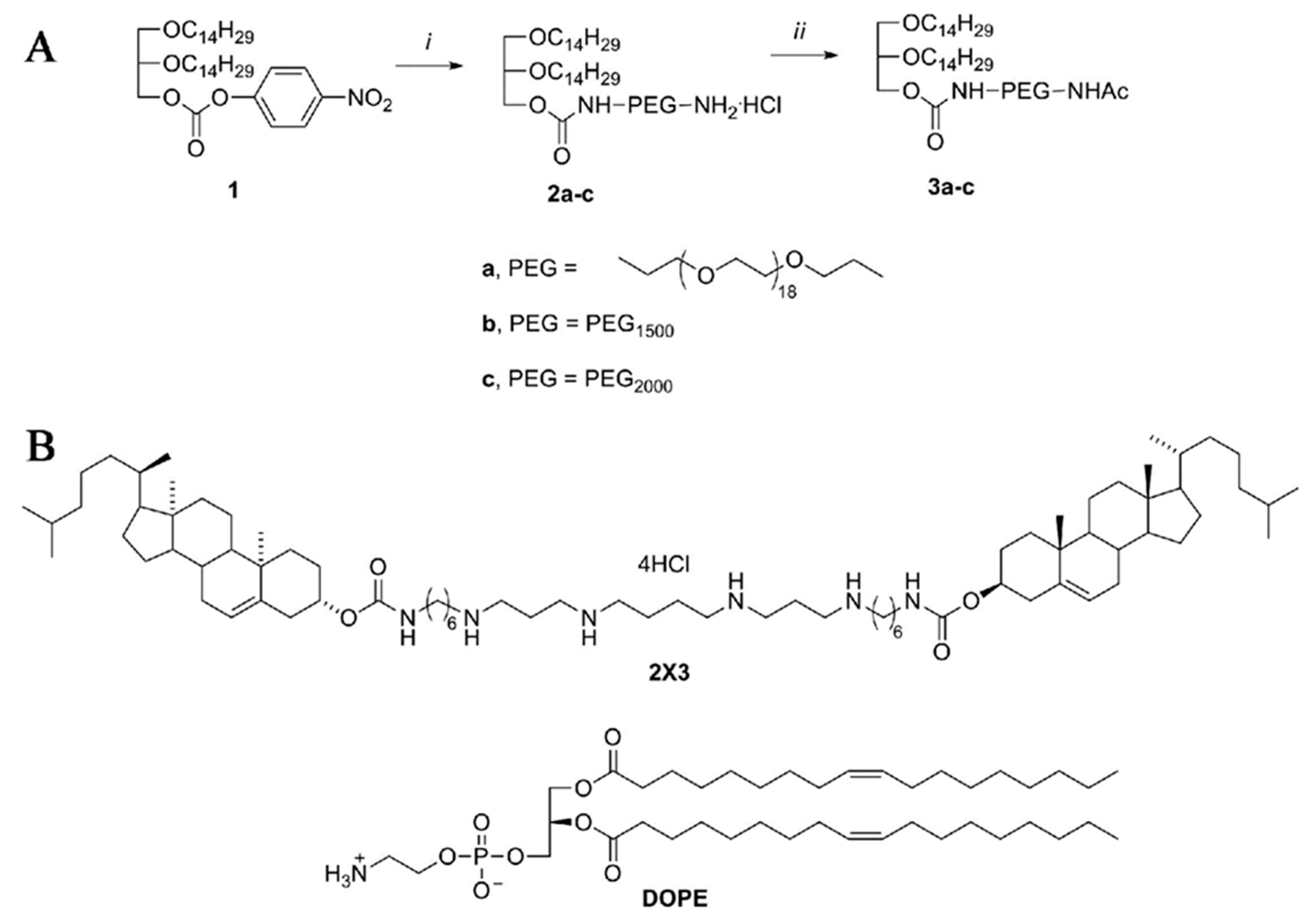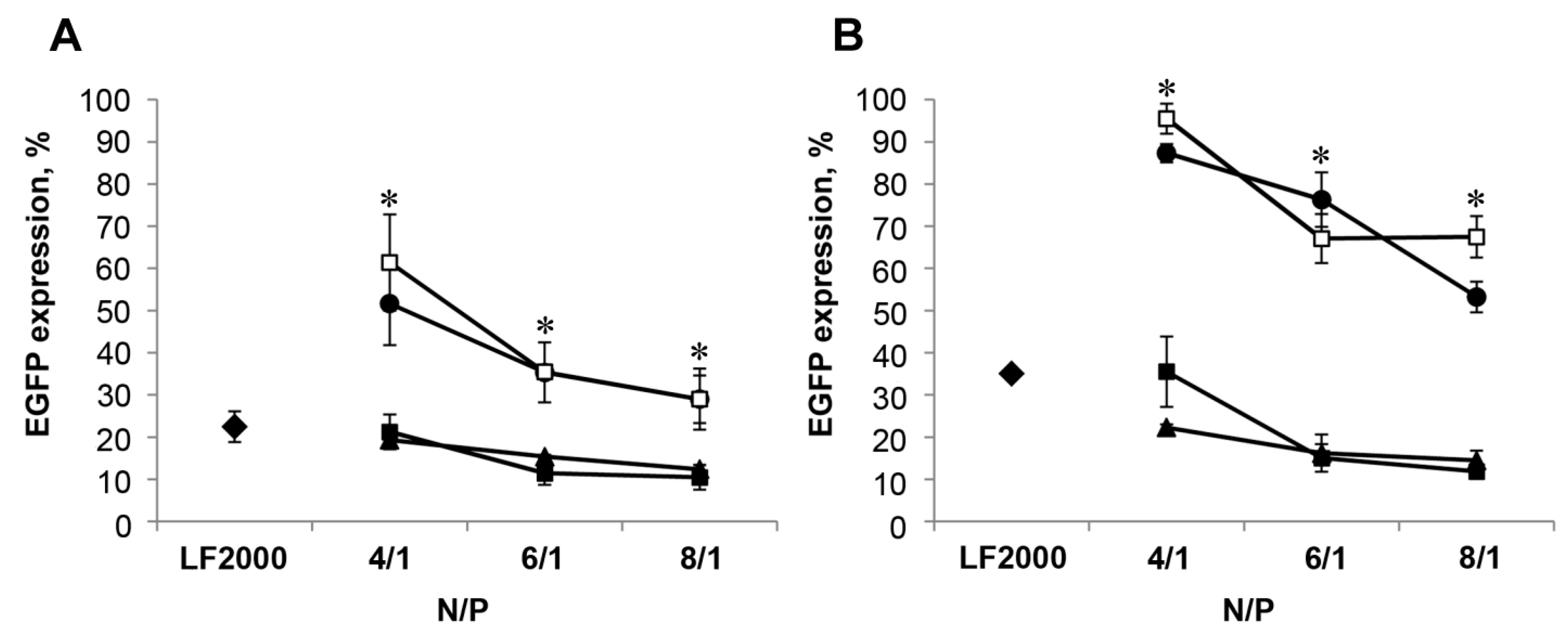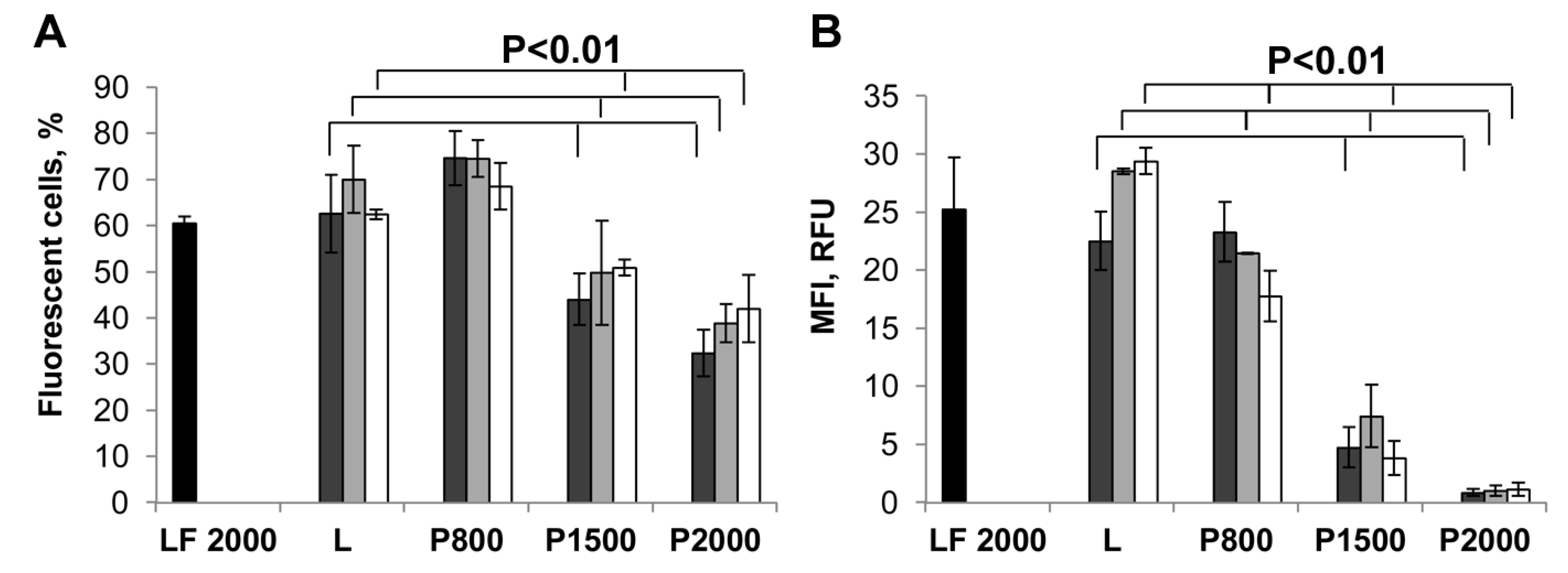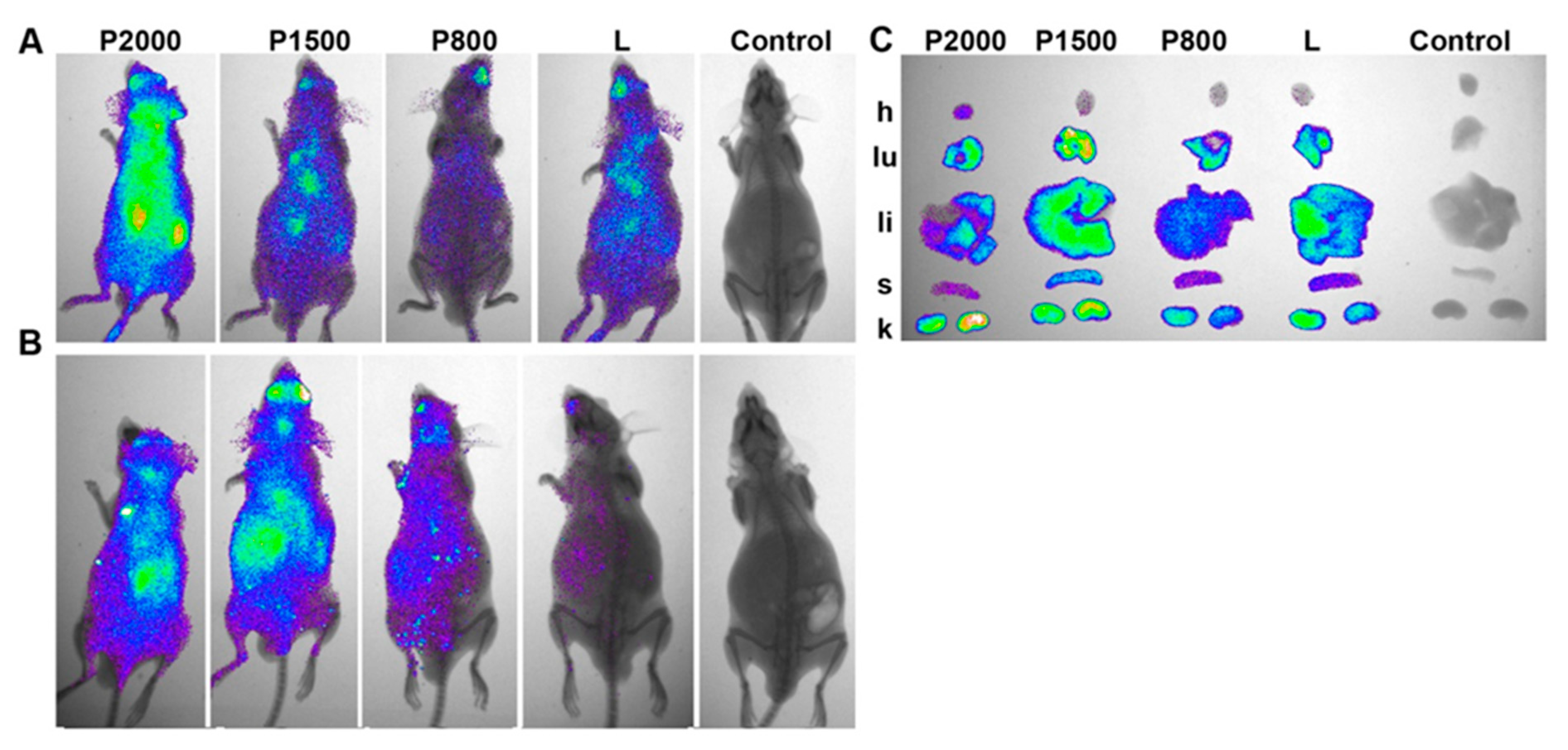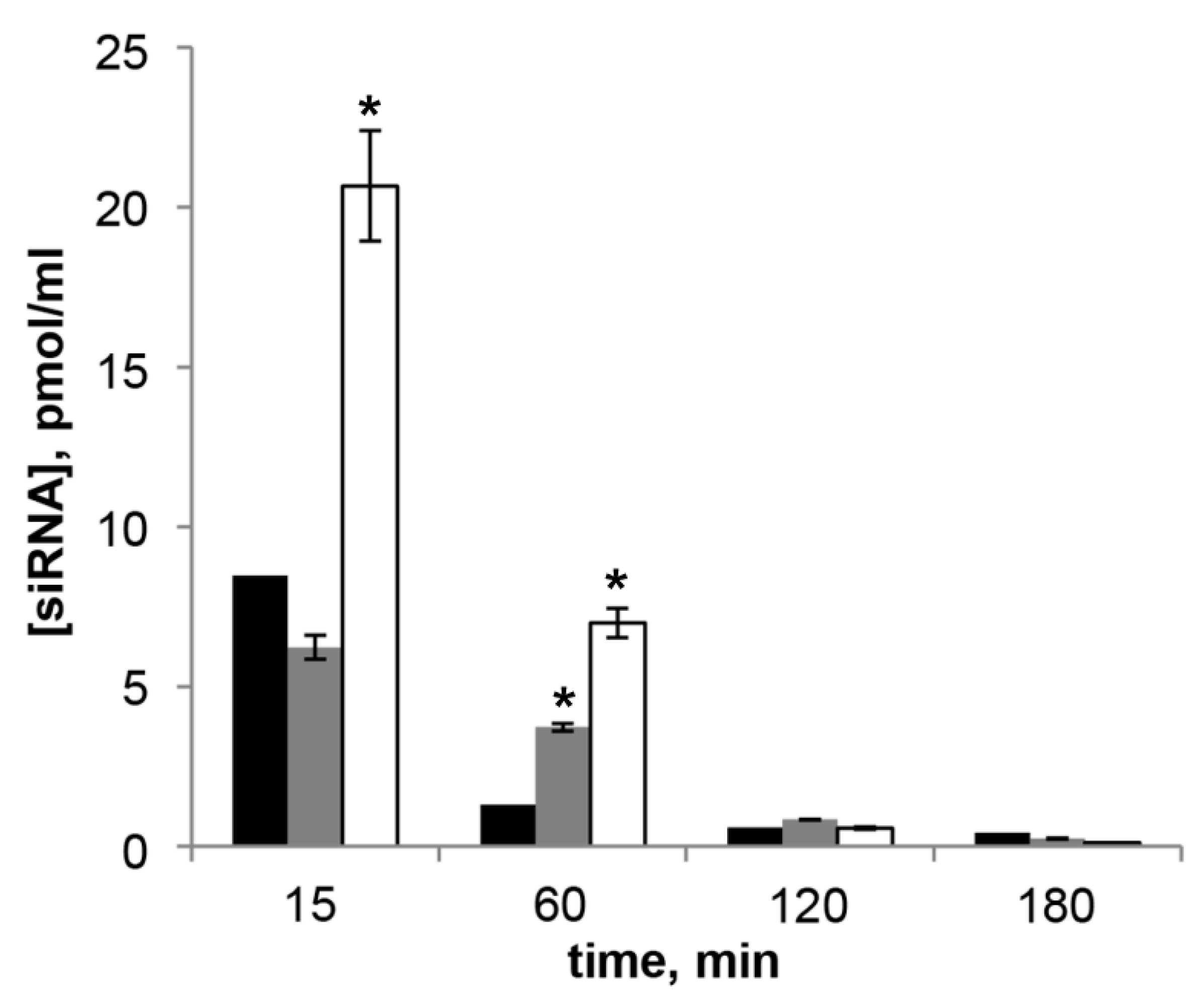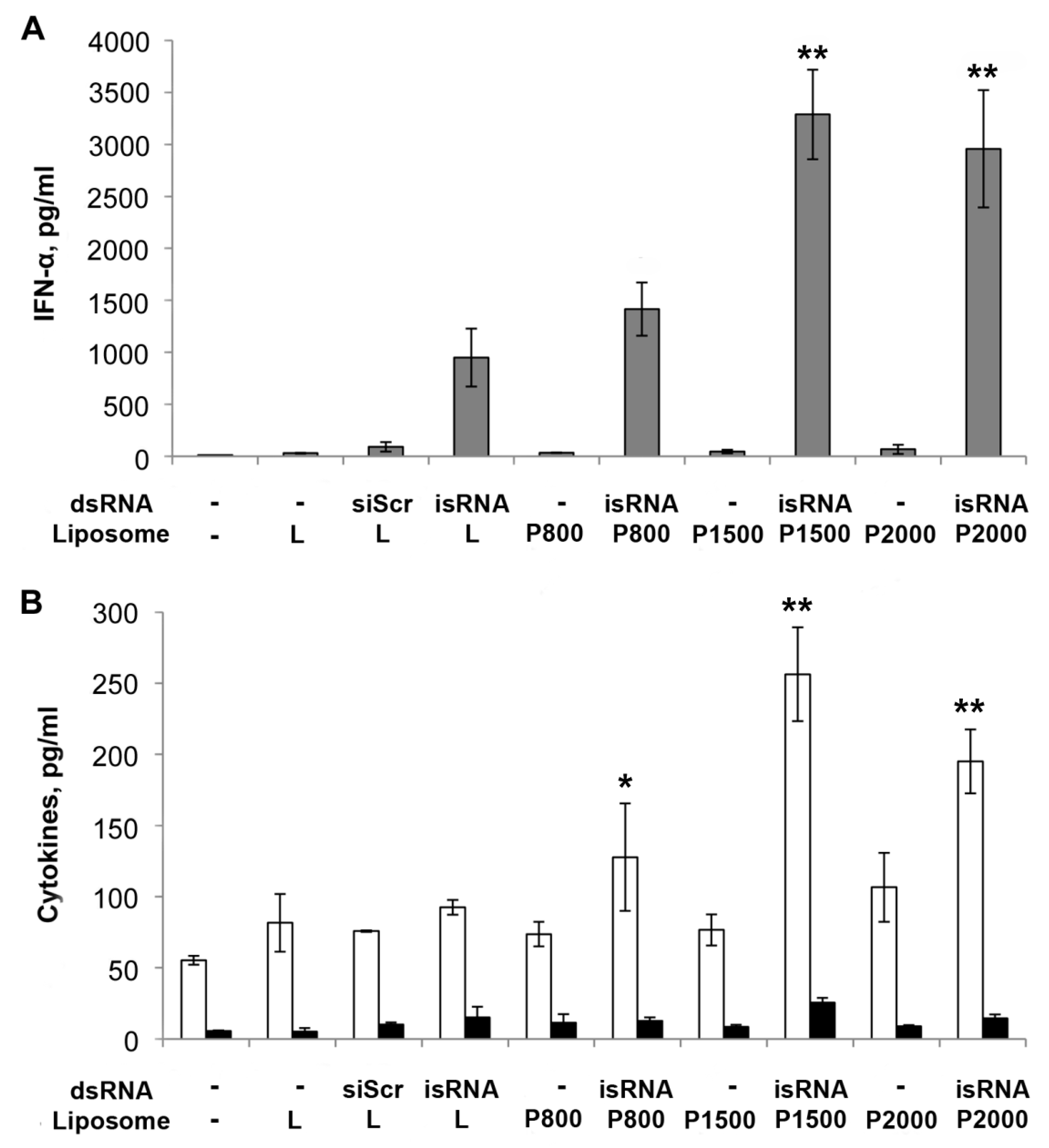1. Introduction
At present, the prospects of therapeutic preparations based on nucleic acids have been proven and small interfering RNA, microRNA, antisense oligonucleotides, aptamers and genomic editing systems are widely used in experimental biomedicine. The use of these biologically active substances in therapy is hampered by the fact that their effective targeted delivery to cells has not been solved to date. Two main approaches are used to ensure the delivery of therapeutic nucleic acids to target cells: the formation of complexes with different particles and polymers [
1] and bioconjugation with lipophilic molecules, antibodies, aptamers and amphiphiles [
2]. Unfortunately, currently used polymers are quite toxic, and the effectiveness of bioconjugates is manifested only at high concentrations due to their removal from the bloodstream through filtration in the kidneys and deposition of the drug trapped in endosomes within the cells followed by their slow release. Compositions containing cationic lipids that efficiently interact with a negatively charged nucleic acid to form lipoplexes are widely used for the delivery of therapeutic nucleic acids. It has been shown that cationic lipoplexes predominantly accumulate in highly vascularized organs: liver, kidney, heart and lungs, but they do not have any cell or tissue specificity. Therefore, lipoplexes carrying ligands to specific cellular receptors are used to develop delivery vehicles for therapeutic nucleic acids [
3,
4,
5], which reduces the overall toxic effect on the body and ensures the accumulation of an effective therapeutic dose in the target organ. Cationic lipoplexes, which are highly effective for delivering nucleic acids in cell culture, are less effective in the body due to the toxicity associated with the interactions of a positively charged particle with proteins and blood cells, and also due to the recognition and absorption of these particles by macrophages [
6]. Therefore, the main tasks of creating drugs based on nucleic acids are stabilization of the drug in the bloodstream, ensuring its primary accumulation in target cells, reducing the rate of excretion of the drug and improving bioavailability. It is important to provide a particle size of 50–100 nm for use in microvesicles in vivo; it is preferable that their surface be neutral or slightly negatively charged. Since the packing of nucleic acids into neutral liposomes is a difficult task, the development of therapeutic nucleic acids delivery carriers utilizes a variety of multilayer structures that shield the charge of the nucleic acids. Modification of the surface of liposomes, creating a protective layer, is considered an effective strategy for increasing the time of the drug in the bloodstream. Most often, polyethylene glycol (PEG) is used for this purpose, since PEGylated nanoparticles are stable in the bloodstream and are effectively delivered to tumor tissue due to the Enhanced permeability and Retention (EPR) effect. On the other hand, PEGylation impairs a number of properties of lipid nanoparticles, which are critical for achieving a therapeutic effect. Negative effects are connected with the fact that PEGylation impairs transfection properties of liposomes [
7], hinders the release of the therapeutic cargo from endosomes [
8] and in some cases causes accelerated blood clearance (ABS), and the contribution of these effects in pharmacokinetics depends on the size of the PEG, the type of lipoconjugate and the composition of the liposome [
9,
10,
11].
Previously, we developed an effective liposomal nucleic acid delivery system based on the polycationic amphiphile 1,26-bis(cholest-5-en-3β-yloxycarbonylamino)-7,11,16,20-tetraazahexacosan tetrahydrochloride (2X3) and the lipid-helper dioleoylphosphatidylethanolamine (DOPE) [
12,
13,
14], which effectively delivers nucleic acids in vitro and in vivo and showed that the incorporation of a folic acid-containing lipoconjugate into the lipid composition provides targeted delivery to tumors that express folate receptors at a high level [
5].
Within this study, we synthesized PEG-containing lipoconjugates that differed in the molecular weight of PEG (800, 1500 and 2000 Da), examined the physicochemical properties of liposomes containing them and determined their ability to transfect plasmid DNA and siRNA in cell culture, as well as biodistribution and biological activity of the obtained lipoplexes in mice. It was determined that increasing the length of the PEG chain reduces the transfection activity of liposomes in vitro, but improving biodistribution increases the circulation time in the bloodstream and enhances the interferon-inducing activity of immunostimulating RNA (isRNA) in vivo.
3. Discussion
The physicochemical characteristics and biological properties of PEG-modified cationic liposomes are influenced by the structure of the PEG-containing lipid and its molecular weight [
22], as well as its quantitative content in the liposomes [
23]. Therefore, in order to select the optimal PEG-containing lipoconjugate for use as a protective shield or a spacer for attachment of the targeting ligands to the earlier developed 2X3-DOPE delivery system [
12], it was necessary to vary the length of the PEG chain.
Apart from PEG length, PEG density is also an important factor affecting the performance of a nanocarrier [
24,
25]. The quantitative content of PEG-containing lipid in the delivery systems of nucleic acids varies from 0.5 to 30% [
26,
27,
28]. To ensure the most effective protection against interaction with serum proteins, the optimal content of PEG-lipoconjugate is in the range of 2 to 5% [
26]. We used 2M% of PEG-containing lipoconjugates in liposomes, which corresponds to the composition of folate-containing liposomes described earlier, with a folate-lipoconjugated PEG (M.W. 800) spacer between folate and the anchor group 2,3-di-
O-tetradecylglycerol. We showed that the incorporation of such a conjugate into liposomes (2 M%) did not alter the particle size or homogeneity and did not increase the toxicity in a cell culture assay. The same anchor group was used to prepare a series of PEG-lipoconjugates in this study.
The molecular weight of the PEG used to modify delivery systems ranges 350 Da to 40 kDa [
29,
30] in particular, the most often used lipoconjugates contain PEG residues with 2 kDa M.W. [
22,
27,
31]. The obtained data showed (
Table 1) that PEG lipoconjugates with different PEG lengths do not significantly affect the size or homogeneity of the liposomes containing lipoconjugates. A slight decrease in the size of
P liposomes was observed in comparison with the conventional delivery system
L; this difference could affect efficiency of the in vivo accumulation in the tissues. It should be noted that lipoplexes formed with siRNA presented more compact particles formed at high N/P ratios in the case of PEG-containing liposomes, than when with
L liposomes (
Table 2). At a low N/P ratio, the changes were non-linear and the particle size decreased in the order
P2000 >
L >
P1500 >
P800. With a ratio N/P ≥ 2/1, the ξ potential of lipoplexes becomes positive and also decreases in the order
L >
P800 >
P1500 >
P2000.
Investigation of the ability of the obtained liposomes to mediate the delivery of plasmid DNA and siRNA in cell culture has shown that liposomes containing a short PEG-chain lipoconjugate behave in the same way as the liposomes
L, ensuring effective delivery of therapeutic nucleic acids to target cells and the manifestation of their biological activity both in serum-free medium and in serum-containing medium (
Figure 2 and
Figure 3). Elongation of the PEG chain leads to a dramatic drop in the efficiency of transfection, and to a corresponding decrease in the biological activity of nucleic acids under the all conditions used [
22].
Analysis of the accumulation of siRNA/liposome
P lipoplexes formed at N/P = 4/1 in mouse organs after i.v. administration showed that the total accumulation in organs has a similar level for all lipoplexes, the highest accumulation of siRNA in the organs of mice was observed after delivery with
P1500 liposomes (
Figure 4). This result correlates well with the fact that these liposomes form with siRNA lipoplexes (N/P ratio 4/1) with the smallest size, 93.1 nM.
Biodistribution of siRNA had similar characteristics when liposomes L, P800 and P1500 were used for delivery, the main difference was observed when using P2000: the accumulation in the kidneys and heart increased significantly, while the accumulation in the spleen and liver decreased.
In order to accumulate in sufficient quantities in organs or in a tumor, lipoplexes must overcome, first of all, a vascular barrier and for this purpose their size should correspond to the properties of the vasculature in the target organ, and the lipoplexes themselves should be present for sufficient time in the bloodstream to ensure effective accumulation. It was demonstrated that liposomes smaller than 100 nm in diameter interacted to a lesser extent with plasma proteins, evaded capture by the RES and had a longer half-life in the blood [
32].
PEGylation can significantly improve the pharmacokinetic and pharmacodynamic properties of liposomes and increase their time in the bloodstream, making them invisible to RES [
23]. Nevertheless, the properties of PEG-containing liposomes can differ substantially: it was reported, that the half-life time of PEGylated liposomes 250 nm in diameter were about half as long as for the liposomes 100 nm in diameter with similar lipid composition [
33]. The data obtained by us showed that the presence of PEG and the length of its chain have a significant effect on the circulation of lipoplexes in the bloodstream, the time of circulation increases significantly with increasing mol. weight of PEG.
It has been shown for various lipids included in delivery systems for therapeutic agents that they can cause an immunostimulatory effect by alone or intensify the action of other immunostimulators. It was reported that dendritic cells can be targeted precisely and effectively in vivo using intravenously administered RNA-lipoplexes, without the need for functionalization of particles with molecular ligands [
34]. Hashimoto et al. demonstrated that immunostimulatory isRNA-containing a PEGylated lipoplex (PEGylated siRNAlipoplex) activates the immune system via TLR7 receptor [
35]. Based on these data, we decided to investigate how the length of PEG affects the ability of the liposomes to deliver immunostimulating RNA to immune cells and induce cytokine production by these cells in mice. Earlier we showed that the developed core system
L effectively delivers isRNA to the immune cells and induces the synthesis of alpha-interferon and the elevation of the level of its production in the case of core system
L is much higher than when commercially available transfection agent Lipofectamine 2000 was used [
19,
20,
21]. At the same time, the core system L itself does not possess immunostimulating properties. The data obtained by us showed that liposomes with longer PEG-linkers (
P1500 and
P2000) significantly (up to three times) increase the immunostimulating effect of isRNA without activation of the synthesis of tumor necrosis factor (
Figure 5).
Thus, we synthesized PEG-containing lipoconjugates that differed in the molecular weight of PEG (800, 1500 and 2000 kDa). We showed that increasing the length of PEG in the lipoconjugate decreased the effectiveness of the delivery of nucleic acids by the liposomes containing these lipoconjugates in vitro, but improved biodistribution, duration of circulation in the bloodstream and the efficiency of delivery of isRNA in vivo. PEG-containing lipoconjugates obtained in this work can be effectively used to improve the properties of the delivery of isRNAs and also for the design of targeted delivery systems with increased circulating time in the bloodstream.
4. Materials and Methods
4.1. General Information
Compounds
1 and
2а were obtained earlier [
5,
15]. Poly(ethylene glycol) bis(3-aminopropyl) terminated (1500 Da) and poly(ethylene glycol) bis(amine) (2000 Da) were obtained from Aldrich (St. Louis, MO, USA); other solvents and reagents were purchased from Russian companies (Dia-M, Moscow, Russia; Helicon, Moscow, Russia). CH
2Cl
2 and Et
3N were refluxed with CaH
2 and distilled prior to the reaction. Pyridine was refluxed with KOH and distilled prior to the reaction. Column chromatography was carried out on silica gel Kieselgel 60 (0.040–0.063 mm or 0.063–0.200 mm, Merck, Darmstadt, Germany). Ion-exchange column chromatography was carried out on Dowex H
+ (DuPont, Wilmington, DE, USA).
1H and
13C-NMR spectra were recorded on Avance DPX-300 and Avance DRX-500 pulse Fourier transform spectrometers (Bruker, Karlsruhe, Germany) in CDCl
3 unless otherwise stated. Chemical shifts were recorded in ppm on the δ scale relative to the CHCl
3 solvent residual peak (7.26 ppm for
1H and 77.0 ppm for
13C-NMR spectra). Coupling constants (
J) are absolute values and recorded in Hz. Mass spectra were run on an Ultraflex time-of-flight mass spectrometer (Bruker, Karlsruhe, Germany) with matrix assisted laser desorption/ ionization (MALDI) and on a Finnigan MAT 900XL-TRAP mass spectrometer (San Jose, CA, USA) with electrospray ionization (ESI). The peak with maximal intensity of PEG were chosen to calculated molecular ion. The spectra exhibited a bell-shaped distribution of 44 Da-spaced lines centered at 2096.615 Da for
2b, 2138.272 Da for
3b, 2464.513 Da for
2c, 2506.662 Da for
3c. Particle size and zeta potential of liposomes and complexes with nucleic acids were measured using dynamic light scattering (DLS) by a Delsa Nano C particle analyzer (Beckman Coulter, Brea, CA, USA) at 25°C. FACS analysis was performed by a flow cytometer NovoCyte 3000 (ACEA Biosciences, Inc., San Diego, CA, USA).
4.2. General Method for the Preparation of Compounds 2b and 2c
A solution of diamine (1.3 eq) in anhydrous CH2Cl2 (4 mL) and anhydrous Et3N (4 eq) were added to a solution of rac-1-О-(4-nitrophenyloxycarbonyl)-2,3-di-O-tetradecylglycerol (1) (1 eq) in anhydrous CH2Cl2 (3 mL) and the reaction mixture was stirred at 24 °С for 4 h, and evaporated to dryness in a vacuum. The residue was chromatographed on a cation-exchange column (Dowex H+) eluted with MeOH: aq. NH3:CHCl3 (1:0:0 → 5:1:1) and then on a silica gel column eluted with CHCl3:MeOH (20:1 → 10:1). The quality of initial reagents, yield and physico-chemical characteristics of compounds 2b and c are described below.
O-(3-Ammoniopropyl)-O′-[3-(rac-2,3-di(tetradecyloxy)prop-1-yloxycarbonyl) aminopropyl] poly(ethylene glycol1500) hydrochloride (2b): rac-1-О-(4-nitrophenyloxycarbonyl)-2,3-di-O-tetradecylglycerol (182 mg, 0.280 mmol), poly(ethylene glycol) bis(3-aminopropyl) terminated (1500 Da) (650 mg, 0.433 mmol), Et3N (150 µL). Compound 2b was obtained at 20% yield (0.115 g) as a white crystallizing oil. 1H-NMR NMR (300 MHz, CDCl3-CD3OD, 6:1): 0.81 (t, J = 6.7 Hz, 6H, 2 (CH2)11Me,); 1.11–1.29 (m, 44H, 2 (CH2)11Me); 1.44–1.54 (m, 4H, 2 OCH2CH2); 1.66–1.75 (m, 2H, NH2CH2CH2); 1.84–1.93 (m, 2H, NHCH2CH2); 3.14–3.20 (m, 2H, CH2NH2); 3.26–3.32 (m, 2H, NHCH2); 3.34–3.73 (m, 143H, CH2(OCH2CH2)33OCH2, 2 OCH2CH2, OCH2CHO); 3.96–4.11 (m, 2H, CH2OC(O)). 13С-NMR (125 MHz, CDCl3): 8.35, 13.75, 22.39, 25.76, 25.81, 26.06, 29.07, 29.21, 29.36, 29.40, 29.72, 31.64, 38.19, 39.76, 42.62, 46.03, 63.82, 68.79, 68.85, 69.60, 69.73, 69.77, 69.84, 69.92, 69.96, 70.03, 70.19, 70.37, 71.55, 76.70, 156.63. MS (MALDI) m/z: [M − HCl + H]+ calcd for C104H211N2O38, 2096.464; found: 2096.615.
O-(2-Ammonioethyl)-O′-[2-(rac-2,3-di(tetradecyloxy)prop-1-yloxycarbonyl)aminoethyl] poly(ethylene glycol2000) hydrochloride (2с): rac-1-О-(4-Nitrophenyloxycarbonyl)-2,3-di-O-tetradecylglycerol (47 mg, 0.072 mmol), poly(ethylene glycol) bis(amine) (2000 Da) (208 mg, 0.104 mmol), Et3N (50 µL). The compound 2c was obtained in 38% yield (0.068 g) as white crystallizing oil. 1H-NMR (300 MHz, CDCl3): 0.81 (t, J = 6.7 Hz, 6H, 2 (CH2)11Me,); 1.10–1.30 (m, 44H, 2 (CH2)11Me); 1.43–1.53 (m, 4H, 2 OCH2CH2); 3.07–3.15 (m, 2H, CH2NH2); 3.24–3.33 (m, 2H, NHCH2); 3.33–3.75 (m, 179H, CH2(OCH2CH2)42OCH2, 2 OCH2CH2, OCH2CHO); 4.01 (dd, J = 5.4, J = 11.6, 1H) and 4.08–4.15 (m, 1H, CH2OC(O)); 5.15–5.22 (m, 1H, CONH). MS (MALDI) m/z: [M – HCl + H]+ calcd for C120H243N2O47, 2464.669; found: 2464.513.
4.3. The General Method for the Preparation of Compounds 3a–c
Anhydrous pyridine (5 eq) and acetic anhydride (5 eq) were added to a solution of compounds 2а–с (1 eq) in anhydrous CH2Cl2 (2 mL) and the reaction mixture was stirred at 24 °С for 6 hours. The solvent was evaporated to dryness in a vacuum. The product was isolated by ion-exchange column chromatography (MeOH → MeOH – aq. NH3, 5:1). The quality of initial reagents, yield and physico-chemical characteristics of compounds 3 are described below.
O-(2-(Acet)amidoethyl)-O′-[2-(rac-2,3-di(tetradecyloxy)prop-1-yloxycarbonyl)aminoethyl] octadecaethylene glycol (3а): compound 2a (38.7 mg, 0.0275 mmol), acetic anhydride (36 µL), pyridine (36 µL). The compound 3a was obtained in 88% yield (0.035 g) as white crystallizing oil. 1H-NMR (500 MHz, CDCl3): 0.81 (t, J = 6.7 Hz, 6H, 2 (CH2)11Me); 1.10–1.29 (m, 44H, 2 (CH2)11Me); 1.44–1.57 (m, 4H, 2 OCH2CH2); 1.91(s, 3H, CH3COO); 3.25–3.68 (m, 86H, 2 NHCH2, CH2(OCH2CH2)18OCH2, 2 OCH2CH2, OCH2CHO); 3.68–3.77 (m, 1H, OCH2CHO); 4.02 (dd, J = 5.4 Hz, J = 11.4 Hz, 1H) and 4.07–4.15 (m, 1H, CH2OC(O)); 5.21–5.30 (m, 1H, CONH); 6.46–6.56 (m, 1H, CONH). 13С-NMR (125 MHz, CDCl3): 14.04, 22.61, 25.99, 26.04, 29.28, 29.43, 29.58, 29.61, 29.98, 31.85, 39.26, 40.82, 69.80, 70.02, 70.14, 70.27, 70.51, 71.71, 170.28. MS (MALDI) m/z: [M + H]+ calcd for C74H149N2O24, 1450.050; found: 1449.042.
O-(3-(Acetamidopropyl)-O′-[3-(rac-2,3-di(tetradecyloxy)prop-1-yloxycarbonyl)aminopropyl] poly(ethylene glycol1500) (3b): compound 2b (50.9 mg, 0.0243 mmol), acetic anhydride (24 µL), pyridine (20 µL). The compound 3b was obtained in 77% yield (0.040 g) as white crystallizing oil. 1H-NMR (300 MHz, CDCl3): 0.81 (t, J = 6.7 Hz, 6H, 2 (CH2)11Me,); 1.13–1.29 (m, 44H, 2 (CH2)11Me); 1.43–1.52 (m, 4H, 2 OCH2CH2); 1.66–1.75 (m, 4H, 2 NHCH2CH2); 1.88 (s, 3H, CH3COO); 3.17–3.25 (m, 2H, NHCH2); 3.26–3.32 (m, 2H, NHCH2); 3.33–3.63 (m, 142H, CH2(OCH2CH2)33OCH2, 2 OCH2CH2, OCH2CHO); 3.69–3.73 (m, 1H, OCH2CHO); 4.01 (dd, J = 5.2, J = 11.5, 1H) and 4.06–4.14 (m, 1H, CH2OC(O)); 5.07–5.14 (m, 1H, CONH); 6.26–6.35 (m, 1H, CONH). MS (MALDI) m/z: [M + H]+ calcd for C106H213N2O39, 2138.475; found: 2138.272.
O-(2-(Acetamidoethyl)-O′-[2-(rac-2,3-di(tetradecyloxy)prop-1-yloxycarbonyl)aminoethyl] poly(ethylene glycol2000) (3с): compound 2c (23.3 mg, 0.0094 mmol), acetic anhydride (50 µL), pyridine (50 µL). The compound 3c was obtained in 80% yield (0.019 g) as white crystallizing oil. 1H-NMR (300 MHz, CDCl3-CD3OD, 6:1): 0.81 (t, J = 6.7 Hz, 6H, 2(CH2)11Me,); 1.12–1.32 (m, 44H, 2(CH2)11Me); 1.44–1.55 (m, 4H, 2 OCH2CH2); 1.91 (s, 3H, CH3COO); 3.21–3.68 (m, 182H, 2 NHCH2, CH2(OCH2CH2)42OCH2, 2 OCH2CH2, OCH2CHO); 3.68–3.74 (m, 1H, OCH2CHO); 4.01 (dd, J = 5.4, J = 11.6, 1H) and 4.06–4.13 (m, 1H, CH2OC(O)). 13С-NMR (125 MHz, CDCl3): 13.84, 22.36, 22.52, 25.94, 29.20, 29.35, 29.50, 29.54, 31.78, 39.20, 69.53, 69.93, 70.33, 71.71, 109.20, 160.10. MS (MALDI) m/z: [M + H]+ calcd for C122H245N2O48, 2506.679; found: 2506.662.
4.4. Liposome Preparation
All liposomal formulations were prepared by hydrating thin lipid film method [
12]. Briefly, a solution of the polycationic lipid 1,26-bis(cholest-5-en-3β-yloxycarbonylamino)-7,11,16,20-tetraazahexacosan tetrahydrochloride (2X3) [
13] in a mixture of CHCl
3:CH
3OH (1:1 mol.) was added to a solution of dioleoylphosphatidylethanolamine (DOPE, Avanti Polar Lipids, Alabaster, AL, USA) in CHCl
3 at a molar ratio of 1:1, and gently stirred. A solution of lipoconjugate
3a–
c (2 M%) in CHCl
3:CH
3OH (1:1) was added to the 2X3-DOPE mixture, and organic solvents were removed in vacuo. The obtained lipid film was dried for 4 h at 0.1 Torr to remove residual organic solvents and was hydrated in deionized water (MilliQ, Burlington, MA, USA) at 4°C overnight. The resulting liposomal dispersion was sonicated for 15 min at 70–75 °C in a bath-type sonicator (Bandelin Sonorex Digitec DT 52H, Berlin, Germany) flushed with argon and stored at 4 °C. In the resulting dispersion, the cationic lipid 2X3 concentration was 1 mM.
4.5. Liposome Sizes and Zeta Potentials
Particle size and zeta potential was measured using a Delsa Nano dynamic light scattering instrument with zeta-sizing capacity (Beckman Coulter, Brea, CA, USA). For lipoplex characterization, 50 μL of nucleic acid solution prepared in MilliQ water was mixed with 50 μL of liposome solution taken at the appropriate N/P ratio. Then, after 20 min of incubation at room temperature, the analysis of size was performed using a 100 μL microcuvette. For zeta-potential determination, 900 μL of MilliQ water was added to the sample and surface potential was recorded in a 1 mL cuvette.
4.6. Plasmid and RNA
pEGFP-C2 plasmid (Clontech, Heidelberg, Germany) was used for the plasmid DNA (pDNA) transfection experiments. The strands of small interfering RNA (siRNA) or immunostimulating RNA (isRNA) were synthesized on an automatic ASM-800 synthesizer (Biosset, Novosibirsk, Russia) using solid-phase phosphoramidite synthesis protocols [
36] optimized for the instrument, with a 10 min coupling step for 2′-
O-TBDMS-protected phosphoramidites and a 6 min coupling step for 2′-
O-methylated phosphoramidites. A C6 CPG 3′-PT-amino-modifier (Glen Research, Sterling, VA, USA) was used for synthesis of the 3′-aminohexyl-containing strand. The following siRNAs and isRNA were used in the present study (2′-
O-methyl-modified C and U nucleotides are designated as Cm and Um): siEGFP targeted to
EGFP mRNA (sense strand 5′-GAACGGCAUCAAGGUGAACTT-3′; antisense strand 5′-GUUCACCUUGAUGCCGUUCTT-3′ [
37]; siScr with no significant homology to any known mouse, rat or human mRNA sequence (sense strand 5′-CAAGUCUCGUAUGUAGUGGUU-3′; antisense strand 5′-CCACUACAUACGAGACUUGUU-3′); siMDR targeted to
MDR1 mRNA (sense strand 5′- GGCUUmGACmAAGUUmGUmAUmAUmGG-3′; antisense strand 5′-AUmAUmACmAACUU mGUCmAAGCCmAA-3′) [
38,
39] and isRNA (strand 1: 5′-AAAUCUGAAAGCCUGACACUUA-3′ and strand 2: 5′-GUGUCAGGCUUUCAGAUUUUUU-3′) [
19]. Cyanine5.5 (Cy5.5) was attached to the 3′-end of the antisense strand of siMDR equipped with a 3′-aminohexyl linker according to the manufacturer’s protocol, using Cy5.5
N-hydroxysuccinimide esters (Biotech Industry Ltd., Moscow, Russia) in 0.1 M Tris buffer (pH 8.4). Isolation of the oligoribonucleotides and the conjugate was accomplished by electrophoresis in a 12% denaturing polyacrylamide gel (dPAAG). The purified oligoribonucleotides were characterized by electrophoretic mobility in 12% dPAAG and by MALDI-TOF-MS. siRNAs and isRNA (50 μM) were annealed in a buffer containing 30 mM HEPES-KOH (pH 7.4), 100 mM sodium acetate and 2 mM magnesium acetate, by heating at 90 °C for 5 min, followed by cooling to room temperature, and stored at −20 °C until required.
4.7. Preparation of Complexes of Cationic Liposomes and Nucleic Acids
Prior to use, the cationic liposome and nucleic acid complexes were formed in serum-free Opti-MEM (Invitrogen, Waltham, MA, USA) by mixing of equal volumes of liposomes and respective nucleic acid solutions in Opti-MEM taken at appropriate concentrations corresponding to a final concentration for in vitro experiments of 2 μg/mL for pEGFP-C2, 50 nM for siEGFP in the well or, for in vivo experiments, of 1 µg/g for Cy-5.5-siMDR, 0.5 µg/g for isRNA; the resulting mixtures were incubated for 20 min at room temperature. NA/liposome complexes were formed at N/P ratios of 4/1, 6/1, and 8/1; N/P ratios are indicated in corresponding figure legends.
4.8. Cell Lines and Culture Conditions
Genetically modified BHK IR780 cells, constantly expressing EGFP, derived from BHK (baby hamster kidney) cells were kindly provided by Prof. V. Prasolov (Engelhardt Institute of Molecular Biology, RAS, Moscow, Russia). HEK 293 (human embryonic kidney), BHK and BHK IR780 cells were grown in DMEM (Sigma, St. Louis, MS, USA) supplemented with 10% fetal bovine serum (FBS, GE Healthcare, Chicago, IL, USA), 100 μg/mL penicillin, 100 μg/mL streptomycin and 0.25 μg/mL amphotericin at 37°C in a humidified atmosphere containing 5% CO2/95% air.
4.9. Cell Viability Assay
The relative amount of living cells after incubation with liposomes was determined by the MTT test [
16]. HEK 293 cells were plated in 96-well culture plates (10
4 cells/well) and incubated with cationic liposomes (final concentration in the well 1–80 μM) for 4 h under serum-free conditions, then serum was added to each well and cells were incubated for a further 20 h. After 24 h of incubation, a solution of MTT (3-(4,5-dimethylthiazolyl)-2,5-diphenyltetrasolium bromide) (Sigma, St. Louis, MS, USA) was added to a final concentration of 0.5 mg/mL, and cells were incubated for an additional 3 h. The culture medium was then removed, formosan crystals were solubilized in DMSO, and the differences in absorbance at 570 and 620 nm were measured spectrophotometrically using a Multiscan RC (Labsystems, Vantaa, Finland). Results are expressed as mean values of measurements for three wells ± SD.
4.10. Transfection of Cells
HEK 293 (1.2 × 105 cells/well) and BHK IR780 (0.15 × 105 cells/well) cells were seeded in 24-well plates one day before transfection. On the day of the experiment, the culture medium of cells was replaced with 200 μL of fresh serum-free or medium supplemented with 10% FBS (see figure legends). The cationic liposome/nucleic acid complexes were pre-formed in serum-free Opti-MEM medium as described above. The lipoplexes were formed at an NA concentration corresponding to a final concentration in the well of 2 μg/mL for pEGFP-C2 and 50 nM for siEGFP. Following pre-incubation at room temperature, the lipoplexes were added to the cells, which were incubated under standard conditions for 4 h. Then the culture medium was replaced with 500 µL of DMEM supplemented with 10% FBS. The cells were allowed to grow under standard conditions for an additional 44 h in the case of pEGFP-C2 delivery or 68 h in the case of siRNA delivery. The level of pEGFP-C2 delivery was evaluated 48 h post-transfection by measuring EGFP expression. The efficiency of siEGFP delivery was determined by inhibition of EGFP expression in BHK IR780 cells measured 72 h after transfection. EGFP expression in the cells was analyzed using a Cytomics FC 500 (Beckman Coulter, Brea, CA, USA) flow cytometer (excitation wave length 488 nm, emission 530 ± 30 nm). 10,000 cells from each sample were analyzed.
4.11. Mice
All animal procedures were carried out in strict accordance with the recommendations for proper use and care of laboratory animals (ECC Directive 86/609/EEC). The protocol was approved by the Committee on the Ethics of Animal Experiments of the Administration of the Siberian Branch of the Russian Academy of Sciences. The experiments were conducted at the Center for Genetic Resources of Laboratory Animals at the Institute of Cytology and Genetics, Siberian Branch, Russian Academy of Sciences (RFMEFI61914X0005 and RFMEFI62114Х0010). 8- to 10-week-old female SCID (SHO-PrkdcscidHrhr) mice with an average weight of 20–22 g from the Center for Genetic Resources of Laboratory Animals at the Institute Cytology and Genetics SB RAS were used. Also we used 8–10-week-old male CBA/LacSto (CBA) mice with an average weight of 23–27 g from the vivarium of the Institute of Cytology and Genetics SB RAS. Mice were housed in groups of 8–10 individuals in plastic cages, and had free access to food and water; daylight conditions were normal.
4.12. In Vivo Biodistribution Studies
In vivo real-time fluorescence imaging was used to evaluate the distribution of Cy5.5-labeled siRNA in SCID mice. The In-vivo MS FX PRO Imaging System (Carestream, Rochester, NY, USA) was used to obtain X-rays and, concurrently, near-infrared fluorescence (NIRF) images (Cy5.5: excitation 675 nm, emission 694 nm). Mice were injected intravenously (i.v.) with 1 µg/g Cy5.5-labeled siMDR complexed with cationic liposomes L (2X3-DOPE), P800, P1500 or P2000 (containing lipoconjugates 3a–c, accordingly) at N/P ratio 4/1 in 200 μL Opti-MEM medium. The dose of siRNA was 1 µg/g of mouse body weight. Animals were anesthetized with avertin (150 mg/kg, intraperitoneally) and placed on a heating tray (37 °C). The fluorescence (10 s exposure) and X-ray (15 s exposure) scans were performed at different time points (20 min and 24 h) post-injection. At the end of the experiment, the mice were euthanized and brains, lungs, hearts, livers, spleens and kidneys were collected. Each organ was rinsed with PBS and the fluorescence intensity detected. Fluorescence intensities of organs were measured by creating an automatic ROI with a threshold of 30% of each sample′s maximum intensity, and measuring that area′s mean by multiplying each luminance level by the number of pixels at that level, and then dividing by the total number of gray levels. Fluorescence intensities were normalized to the peak angle of detection and the area of the organ, and figures were then created in Origin 6.1 (v 6.1052, OriginLab, Northampton, MA, USA). Images were batch exported as 16-bit TIFFs, and overlays were completed in Adobe Photoshop CS3 (v 10.0, Adobe Systems, San Jose, CA, USA). Data was obtained from three independent sets of experiments with identical experimental set-ups.
4.13. Quantitative Stem-Loop Real-Time PCR Analysis
CBA/LacSto mice were i.v. injected with 0.5 µg/g isRNA/liposome complexes (N/P = 4/1) and blood plasma samples were collected 15, 60, 120 and 180 min after the last injection. The RNA from plasma samples was isolated according to Landesman et al. [
40]. Briefly, the plasma samples were diluted 1:10 in 0.25% Triton X-100 (PanReac AppliChem, Barcelona, Spain), followed by heating at 95 °С for 10 min. Then, the samples were cooled on ice for 10 min, centrifuged at 13,000 rpm for 20 min at 4 °С and supernatants were collected and kept on ice.
siRNA specific stem-loop qRT-PCR assays were designed according to the instructions of Czimmerer et al. [
41] using UPL-probe based stem-loop quantitative PCR assay design software (Astrid Research, Debrecen, Hungary) (
http://genomics.dote.hu:8080/mirnadesigntool).
The reverse transcription reaction was performed in a final volume of 40 µL containing 2 µL of Triton X-100 preheated plasma supernatant, 4 µL 10 µM siMDR specific stem loop-RT primer (5′-GTTGGCTCTGGTGCAGGGTCCGAGGTATTCGCACCAGAGCCAACTTGGCT-3′) and 34 µL of Master Mix prepared from a M-MuLV–RH Reverse Transcription Kit (Biolabmix, Novosibirsk, Russia). The reaction mixture was incubated at 42 °C for 1 h. The cDNA was amplified in a total volume of 20 µL containing 5 µL of cDNA template, siMDR specific forward (5’-GTTGGGGATATACAACTTGTCA-3′) and reverse (5′-GTGCAGGGTCCGAGGT-3’) primers (1 µM) and BioMaster HS-qPCR SYBR Blue master mix with SYBR Green I fluorescent dye (Biolabmix, Novosibirsk, Russia) using an IQ5 Cycler (Bio-Rad, Hercules, CA, USA). All measurements were done in quadruplicate.
4.14. Analysis of the Level of Cytokines in Mouse Blood Serum
CBA/LacSto mice were i.v. injected with conventional liposome L or liposomes P800, P1500 or P2000 pre-complexed with isRNA (0.5 µg/g, N/P = 4/1), and blood was collected 6 h after injection via head clipping. The serum was prepared from the whole blood by coagulation for 30 min at 37 °C and subsequent centrifugation. The concentrations of IFN-α, TNF-α and IL-6 in the serum were determined by sandwich ELISA kits (BD Biosciences, San Jose, CA, USA) in accordance with the manufacturer’s instructions. The levels of cytokines was measured in duplicate in individual serum samples from three mice per group.
4.15. Statistical Analyses
The variables were expressed as mean ± standard deviation (SD). Mean values were considered significantly different when p < 0.05, using Student’s t test.
